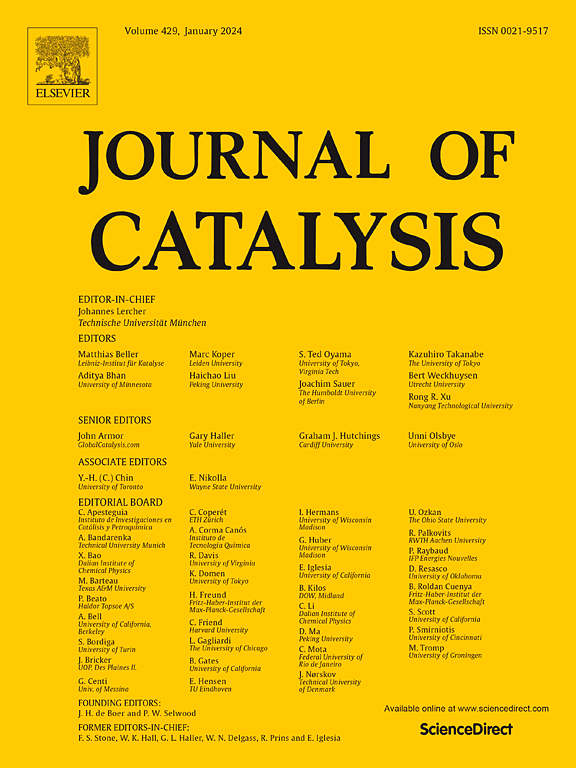Enhanced photothermal catalytic activity of CeO2 through Co-modified for the carbonylation of amine with CO2
IF 6.5
1区 化学
Q2 CHEMISTRY, PHYSICAL
引用次数: 0
Abstract
The photothermal catalytic carbonylation of n-alkylamine with CO2 is one of the most promising “carbon neutral” pathways due to the coupling of CO2 capture and conversion. And the development of high-performance catalysts is vital to the reaction due to the inherent chemical inertness of CO2. Herein, Co-Ce composite oxides with rich oxygen vacancy (Ov) were successfully synthesized via hydrothermal method and applied firstly to photothermal catalytic carbonylation of n-butyl amine with CO2. As optimizing the molar ratio of Co3O4/CeO2, Co3O4/CeO2-0.4 with up to both 95.51 % of n-butylamine conversion and 94.50 % of N,N′-dibutylurea were obtained in the presence of PEG 400 solvent using 500 W Xe lamp as the light source under 110 ℃ and 1.0 MPa for 4 h, respectively. Further characterizations such as XRD, BET, Raman, XPS, CO2/NH3-TPD, UV–Vis, PL and TPC show that both the high photocurrent density and Ov-rich content on the surface of Co3O4/CeO2-0.4 enhances the adsorption-activation of CO2 by facilitating the migration of d electrons from the active sites to the 2π antibonding orbitals of CO2. Finally, a Lewis acid-base interactions mechanism was also proposed in the photothermal catalytic carbonylation of amine by CO2 over the Co-Ce complex oxides.


用共改性方法提高了CeO2的光热催化活性
由于CO2捕获和转化的耦合作用,正烷基胺与CO2的光热催化羰基化反应是最有前途的“碳中性”途径之一。由于CO2固有的化学惰性,高性能催化剂的开发对反应至关重要。本文采用水热法成功合成了富氧空位(Ov)的Co-Ce复合氧化物,并首次应用于CO2催化正丁基胺羰基化反应。通过优化Co3O4/CeO2的摩尔比,在peg400溶剂存在下,在500 W氙灯的照射下,在110℃、1.0 MPa、4 h下,Co3O4/CeO2-0.4的正丁胺转化率可达95.51 %,N,N ' -二丁脲转化率可达94.50 %。进一步的XRD、BET、Raman、XPS、CO2/NH3-TPD、UV-Vis、PL和TPC表征表明,Co3O4/CeO2-0.4表面的高光电流密度和富v含量都促进了d电子从活性位点迁移到CO2的2π反键轨道,从而增强了CO2的吸附活化作用。最后,提出了Co-Ce配合物氧化物上CO2催化胺羰基化反应的Lewis酸碱相互作用机理。
本文章由计算机程序翻译,如有差异,请以英文原文为准。
求助全文
约1分钟内获得全文
求助全文
来源期刊

Journal of Catalysis
工程技术-工程:化工
CiteScore
12.30
自引率
5.50%
发文量
447
审稿时长
31 days
期刊介绍:
The Journal of Catalysis publishes scholarly articles on both heterogeneous and homogeneous catalysis, covering a wide range of chemical transformations. These include various types of catalysis, such as those mediated by photons, plasmons, and electrons. The focus of the studies is to understand the relationship between catalytic function and the underlying chemical properties of surfaces and metal complexes.
The articles in the journal offer innovative concepts and explore the synthesis and kinetics of inorganic solids and homogeneous complexes. Furthermore, they discuss spectroscopic techniques for characterizing catalysts, investigate the interaction of probes and reacting species with catalysts, and employ theoretical methods.
The research presented in the journal should have direct relevance to the field of catalytic processes, addressing either fundamental aspects or applications of catalysis.
 求助内容:
求助内容: 应助结果提醒方式:
应助结果提醒方式:


